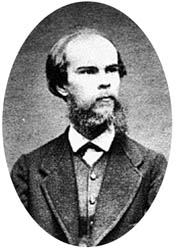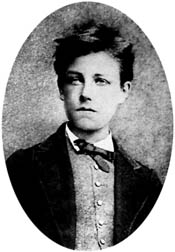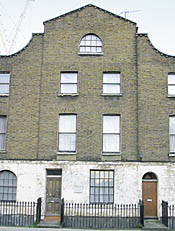|
|
 |
| |
Chasing Rimbaud through our streets
French literary giants Rimbaud and Verlaine carried out their intense love affair in north London and we should honour their presence, writes Gerry Harrison
WHO would have thought that in Camden there once lived in
1873 two great French poets, Arthur Rimbaud and Paul Verlaine,
whose output it can be argued laid the foundation of modern
art and modernism?
It is Rimbaud’s prose-poem, ‘Les Illuminations’,
written at the age of 19 and 20 and even perhaps in part at
No 8 Great College Street, now Royal College Street, that is
seen to be an ancestor of other more often cited examples of
ground-breaking modernistic works such as those of Picasso in
painting, Stravinsky in music, Joyce in novels, TS Eliot in
poetry and a few years later Bunuel in cinema.
The influence of Rimbaud and Verlaine also entered the music
scene of the 1960s when Bob Dylan, John Lennon, Patti Smith
and others acknowledged this. In his album Blood on the Tracks,
Dylan writes “Situations have ended sad/Relationships have
all been bad/Mine have been like Verlaine’s and Rimbaud./But
there’s no way I can compare/All those scenes to this affair/Yer
gonna make me lonesome when you go”.
Dylan’s lyric gives a brief summary of the volatile relationship
between the two poets.
The reputation of Rimbaud and Verlaine in France is perhaps
equivalent to that of Wordsworth and Coleridge in Britain.
However the French tend to award their artists greater respect
than here, but English Heritage has already agreed to the installation
of a Blue Plaque.
But who were these two characters? This was not their first
home in London. A previous one in Howland Street was demolished
to make way for the Telecom Tower.
In France, the older Verlaine had been captivated by Rimbaud’s
charm and rebellious demeanour enough to leave his family.
He ‘eloped’, as he put it, with the talented 17-year-old
to London in 1872. The younger man was the archetypal ‘enfant
terrible’, but one whose extraordinary literary output
ended only a few years later.
They enjoyed London, finding it superior to Paris. This was
then a city of émigrés and political refugees,
and it is recorded that they attend meetings in Soho at which
Karl Marx spoke.
At Great College Street, overlooking the new railway through
Agar Town to St Pancras Station, they spent some months during
the summer of 1873.
Later that year Rimbaud’s ‘Une Saison en Enfer’
(A Season in Hell) was published, which, like his prose-poem
‘Les Illuminations’, published in 1886, did much to
change the shape of European literature.
Whether the gin and hashish of Camden Town was adequate or not,
they enjoyed a life of hovels and general decadence, but their
love affair was now unhappily descending into argument and violence.
An event took place here that had a crucial impact on their
relationship. One July morning Rimbaud spotted his partner returning
from Camden market. In one hand was a fish and in the other
a bottle of olive oil. Verlaine has recorded that Rimbaud ridiculed
his appearance, and in his rage, which was notorious and perhaps
exacerbated by a hangover, he retaliated by swiping his partner
across the face with the fish.
He then stormed off, reached St Katherine’s Dock and took
the first boat which was to Belgium. Rimbaud pawned whatever
clothes and possessions Verlaine had left behind, and followed
Verlaine to Belgium a week later. Verlaine had already written
to him, threatening to blow his brains out.
Their row continued in Brussels, where Verlaine drunkenly shot
his lover, injuring him in the left wrist. The police were called
and Verlaine was finally convicted. He was to spend nearly two
years in prison.
This separation meant that Rimbaud had to carve out his own
life, which in its continuing vagabond way led him to remote
parts of the world.
As a merchant in Abyssinia, whose businesses included gun running,
he became ill, and after a leg amputation he died in Marseille
in 1891, at the age of 37. Out of prison and having survived
even more colourful experiences, Paul Verlaine died in Paris
five years later.
Camden contains many institutions with an international reputation.
Number 8 Royal College Street is one, but it is not yet properly
recognised.
This is a building listed Grade II by English Heritage and on
its Building-at-Risk register.
It is not owned by the council but Camden does have some responsibility
and can threaten enforcement action. The owner, the Royal Veterinary
College, has now decided to sell Nos 6, 8 and 10 as a package.
Rimbaud and Verlaine in Camden Town will not be forgotten, but
I hope that one day I may cycle past and see their home refurbished,
with No 8t Royal College Street proudly displaying its Blue
Plaque. |
|
 |
|




